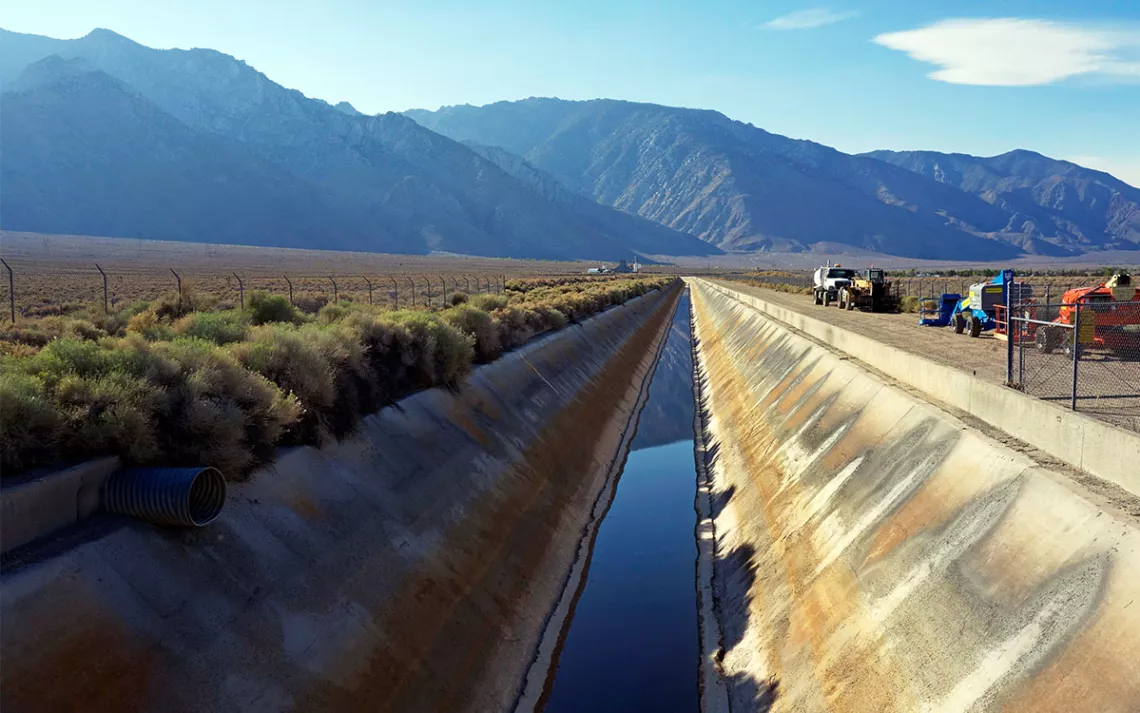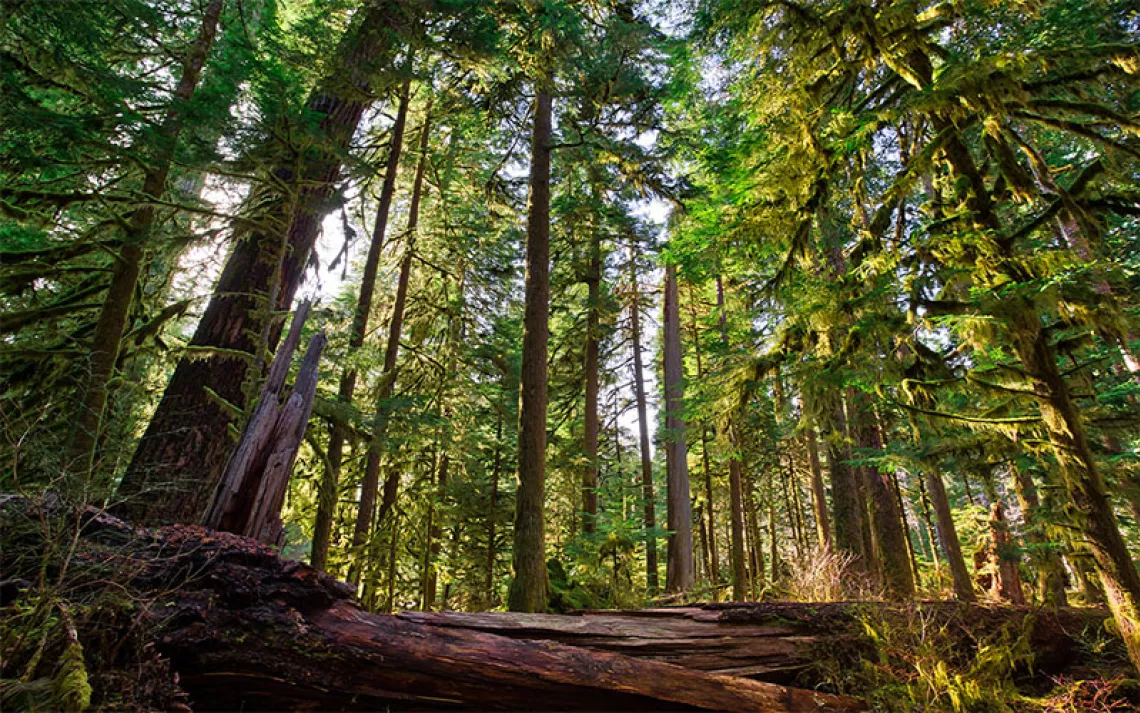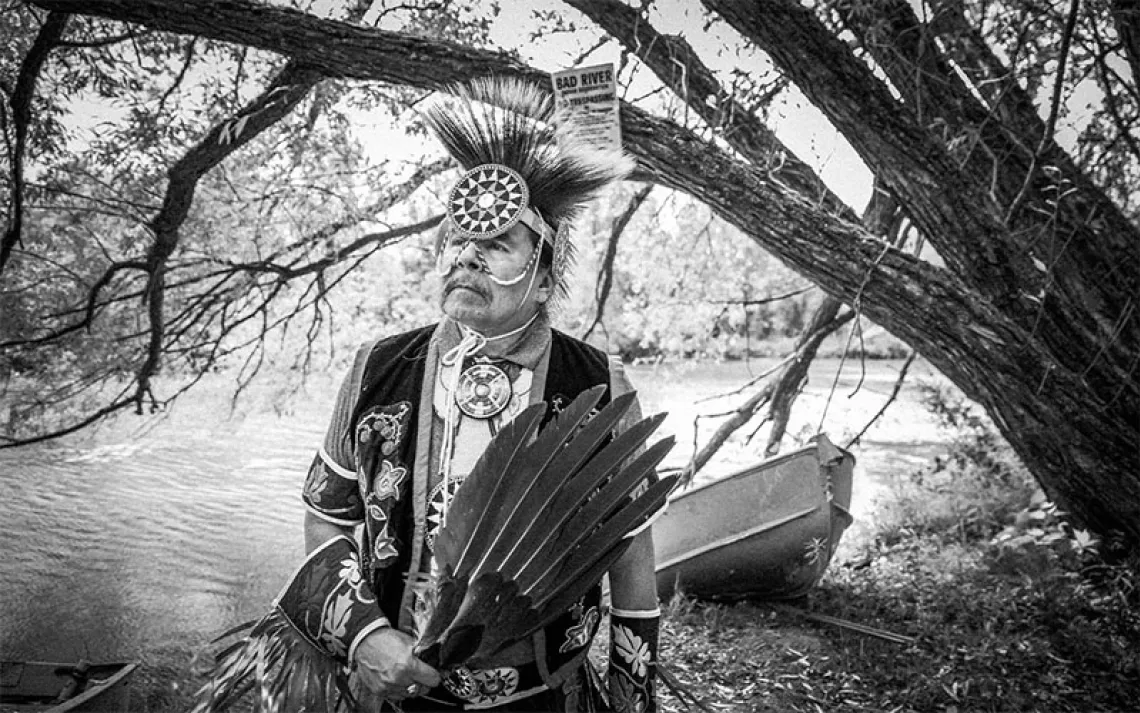Dear Los Angeles: You’re Drinking Indigenous Water
How LA can localize its water supply and finally do right by the Owens Valley Paiute tribes

The Los Angeles Aqueduct. | Photo by Brian Melley/AP
In August 2023, a tropical storm bore down upon Southern California for the first time in 84 years. As Hilary’s northward-rolling blanket of rain touched off mudslides from Hollywood to the San Bernardino Mountains, thigh-deep water floated vehicles in the streets of Cathedral City. To the east, 120 miles of Highway 395 were closed due to flooding and rock slides, pinching off the route between the city of Los Angeles and the once-green valley 300 miles away from which it has, for over a century, sourced fresh water.
Since the early 20th century, Los Angeles has siphoned liquid snow from a beautiful, high-desert basin between the austere peaks of the Sierra Nevada and the softened summits of the White Mountains. In the view of a migratory bird passing overhead, its namesake river cuts a sinuous path through the valley’s heart.
The Owens Valley has never received much rainfall, but it wasn’t always a desert. Historically, ample groundwater and the Owens River provided a water supply so superabundant that the valley’s Indigenous people, the Paiute (in their language, Nüümü) named their homeland Payahuunadü, or “Land of the Flowing Water.” Now, the Owens Valley is a desert by design—the end state of a plot by the architect of Los Angeles, William Mulholland. And the Paiute are still fighting for the right to water taken from them long ago.
*
For at least 15,000 years, the Nüümü (and a smaller population of Shoshone) thrived throughout the Owens Valley, massaging water through hand-dug irrigation ditches to support their crops. They gathered pine nuts and caught fish and wild game.
In the 1850s, white European settlers “discovered” the valley and set about overtaking it. They slaughtered over 200 people, forced the Nüümü into the Owens Lake to drown, and assaulted and raped Native women. In 1863, they removed 1,000 Native people from their homes and marched them to Fort Tejon, on the southern end of the Central Valley, a journey of over 200 miles. Many did not survive the trek—the Dry Lake contains human remains of Nüümü with musket balls in their backs.
By the time the survivors made their way on foot back to Payahuunadü a year later, “All their lands, especially the very fertile lush lands, were claimed by settlers,” says Noah Williams, a member of the Bishop Paiute Tribe. The Nüümü were left to work for the ranchers who had taken their land.
In the early 1900s, it was clear that LA’s population would soon outpace local water supplies. William Mulholland and Fred Eaton, a former Los Angeles mayor, began purchasing land and water rights from ranchers in the Owens Valley. By 1905, the Los Angeles Department of Water and Power (LADWP) owned almost everything in the valley. LA residents approved a bond to construct a gravity-fed aqueduct to the San Fernando Valley, over 200 miles away. Construction was completed in 1913, and water diversion through the Los Angeles Aqueduct began immediately. By 1926, the Owens Lake was a windswept dust bowl.
Annoyed by the presence of the Paiute, who remained after their homeland became LADWP property (often because the concept of ownership was senseless in their worldview), LA set out to solve what they called the “Indian problem.” President Taft had reserved over 67,000 acres in trust for the Native people, but as Teri Red Owl, director of the Owens Valley Indian Water Commission, explains: “When LA found out about it, they went to Washington and lobbied and had those lands removed from trust status for the tribes and set aside ‘for watershed protection for the city of Los Angeles.’”
Then LA launched a PR effort that, Williams says, “framed the tribal people of the valley as vagrants, ‘landless Indians,’ homeless. They declared us wards of the state.” The smear campaign set the stage for their next move: In the 1939 Land Exchange Act, Los Angeles traded 1,511 acres of city-owned land for 3,126 acres of federally reserved Indian lands. The Paiute were concentrated onto 1,500 acres in three postage-stamp parcels: the Bishop, Big Pine, and Lone Pine reservations.
Water rights should have been included in the act that established the reservations, but, perhaps reluctant to put it on the ballot for a two-thirds vote of residents, the City of Los Angeles left water rights out of the exchange, promising the tribes they’d get to it later. Eight-four years have passed—and the Paiute tribes are still waiting.
*
For the past 110 years, Los Angeles has taken water from the Owens Valley in quantities ranging from 230,000 to 500,000 acre-feet per year. The consequences are visible to the naked eye.
North of the Owens Valley, DWP diversions drained Mono Lake, exposing 14,700 acres of chalk-white former lakebed and creating a land bridge that imperils island bird rookeries; the battle over Mono Lake waters is ongoing. The LA aqueduct drained the Owens Lake within 13 years, remaking it as the Owens Dry Lake, which produced dust storms so severe it was named the source of the nation’s worst dust pollution. Since 2014, the DWP has been forced to mitigate the dust by watering the Dry Lake, an accomplishment they note with pride while bemoaning the $2.5 billion it cost LA ratepayers (never mentioning that costly mitigations are the result of sweeping injustices it committed in the name of free water).
In 1970, Los Angeles added a second aqueduct, doubling its capacity to transport water to the city. The new channel primarily ferried groundwater pumped from underneath the valley. Since then, water table levels have dropped by as much as 75 feet in some parts of the Owens Valley. Springs have dried up. Animal life has ebbed; the rabbits the Paiute used to hunt have all but vanished. Plant life is changing too, as fields of grasses shift to scrubland and alkali meadows disappear. Climate change and persistent drought have accelerated the damage.
Meanwhile, the tribes’ cultural, agricultural, and fiscal health have suffered. “We don’t have any economic development,” says Williams. “We don’t really have access to any of our lands, or our waters, and it makes it tough to establish industry. So we’re mostly reliant on federal aid, which, don’t get me wrong, it helps, but the tribal people in this valley have a sense of, this is what we’re reduced to—to be reliant on the government.”
Today the tribe receives a contractual water allotment equivalent to four acre-feet of water per acre of reservation land, to use for irrigation (Owens Valley ranchers and farmers receive five acre-feet per acre). But in recent years, the DWP has begun deducting water from the reservations’ allotment based on how much they estimate the tribes are using for domestic water drawn from wells on the reservations.
Dave Pettijohn, water resources director for the LADWP, explained how to visualize an acre-foot. “If you cover a football field in a foot of water, that’s about a single acre-foot," he says. "Now stack 550,000 of those on top of each other. That’s the amount of water the City of Los Angeles uses in a year.” This stairway to heaven would be 104 miles high, tall enough to reach the thermosphere. It’s so much water, it defies imagination.
Pettijohn pointed to the progress the city has made. Whereas Los Angeles was drawing 500,000 acre-feet of water from the Owens Valley in the 1970s, it now takes (the city uses the word “export,” affirming a self-conception as the true owners of Eastern Sierra water) about 230,000 acre-feet per year—even as the city’s population has grown by a million people—thanks to water conservation measures.
But tribal members say tricky accounting helps a considerable amount of water elude the DWP’s 230,000 acre-foot export figure, including 20,000 acre-feet a year of pumped groundwater that passes through the Fish Springs hatchery, settles out, and passes into the aqueduct—technically logged as in-valley use but gone to LA all the same.
DWP mitigation projects raise local eyebrows too. According to Red Owl, “They’ll say, ‘We’re leaving most of the groundwater that we pump in the valley.’ They report that out, and they make it sound like it’s for good uses. But really, they’re pumping groundwater to restore areas that were damaged by their groundwater pumping. So it makes no sense to us. What damage is this new pumping causing somewhere else?”
The Nüümü are not alone in their struggle. Other tribes in the Eastern Sierra, like the Kutzadika'a of Mono Lake, are fighting a similar battle with the LADWP. Indigenous water rights abuses have come to light in the aftermath of the Maui wildfires. And there’s the Navajo Nation’s recent, heartbreaking Supreme Court loss in their effort to obtain water rights to the Colorado River. As water stress grows across the planet, a conflict of needs gains urgency, raising questions about who has a right to the liquid we all need to survive.
The problem facing the Paiute is one shared by many Indigenous groups: How can the tribes regain water rights, with a city of 4 million sipping from the other end of the straw?
*
There are three primary ways the Paiute could obtain a legal right to Owens Valley water. First, they could complete water rights negotiations under the 1939 Land Exchange Agreement, negotiations attempted but stalled in the 1990s. This time, a federal negotiations team could assist the Nüümü, who lack the resources for a major legal case.
Second, the tribes could try to obtain “first use” or appropriative rights through the State of California Water Board. The “first in time, first in right” rule may grant the tribes hundreds of thousands of acre-feet of water, whereas the 1939 agreement would grant about one-tenth that amount. The holdup: Language in the law requires water usage to be “continuous.” Paiute use of Owens Valley water is not continuous—it’s been interrupted for a century—but not by choice. If the tribes could prove the interruption happened against their will, or lobby to amend the law’s language, it could work.
Finally, the tribes could obtain water rights by getting a measure on the ballot in Los Angeles. The city could relinquish water rights in the Owens Valley to the tribes by a two-thirds vote of LA’s registered voters. It would take a lot of work to build that kind of consensus, but, as Red Owl and Noah point out, a concerted social justice movement could make it happen.
Meanwhile, Los Angeles can continue reducing its need for imported water through groundwater remediation, stormwater capture, water recycling, and of course, conservation. The city is already well on its way to creating more sustainable sources. It currently gets 10 percent of its water locally, with plans to rely on 43 percent local water by 2045, Pettijohn says.
One ambitious and promising reuse effort is Operation NEXT, the plan to recycle 100 percent of the city’s wastewater by 2035. On the conservation front, Pettijohn says the city is “saturated” with things like low-flush toilets; they’re investing in high-efficiency washing machines and recirculation systems on cooling towers and offering $5 per square foot to residents who replace their lawns with California-friendly natives.
Heather Cooley, director of research for the Pacific Institute, says the city has made progress but could be doing far more. A technology known as “advanced metering” could help to detect leaks in the water delivery system, and there’s promise in the city’s recent extension of a ban on so-called non-functional turf. Drought-resilient plants and shade trees would not only reduce water use but also provide urban habitat, support community greening, and save energy.
In response to the idea that Los Angeles has already maximized its water efficiency, Cooley points to a study conducted by the Pacific Institute, which found that “California could reduce urban water use by 30 percent—48 percent through investments in water efficiency measures.”
I asked Pettijohn if he thought Los Angeles could become 100 percent self-sufficient, sourcing all its water locally. “Every major city in this country is taking water from somewhere else,” Pettijohn said. “The idea that somehow it’s feasible for a very large city that’s got 4 million people to live on the water that falls from the sky—that’s very unrealistic.”
A study by UCLA, however, concluded that 100 percent local water is possible for the city by 2050. “The aforementioned … scenarios raise the possibility of achieving 100 percent local self-sufficiency in Los Angeles, without the addition of coastal desalination plants.” That’s an important caveat, because Cooley and Pettijohn agree that the expense and environmental consequences of seawater desalination make it a less than ideal solution.
Meanwhile, the city’s 2020 Urban Water Management Plan, which projects future water sources, shows an increase in locally sourced water. But projections for 2044-45 still show 31 percent of Los Angeles’s water coming from the Metropolitan Water District, which purchases water at $1,209 an acre-foot from Northern California and the Colorado River (another contested source). And in 2044, the DWP still plans on drawing 26 percent of the city’s water from the LA Aqueduct, i.e., from the Owens Valley.
In short, the research shows that Los Angeles can eliminate its need for imported water within the next 30 years using only existing technologies and practices. Yet so far, the DWP has not laid out a plan to go 100 percent local. That may be because, as tribal members point out, such solutions are costly while the water coming out of the Owens Valley is free.
Charging ratepayers for water the city obtains gratis is a major revenue source. Or, as Noah Williams says, “We’re battling the profits.”
*
Last spring, when water returned to Payahuunadü and the Owens Lake partially refilled, migratory birds reappeared. And when a bacteriological outbreak in 2020 forced a temporary halt in groundwater pumping for the Fish Springs hatchery, the water table rose by eight and a half feet in just four months.
Landscapes can recover, often with miraculous speed. The Owens Valley Paiute tribes have the knowledge to restore their ecosystem and manage it sustainably, as their ancestors did for tens of thousands of years. Registered voters in Los Angeles have the power to demand that the city relinquish water rights back to the tribes, and that the DWP develop local water to replace the Owens Valley supply. No one needs to go thirsty; there’s a win-win solution.
Tribal members believe the missing element is education. As Kyndall Noah says, “A lot of people in Los Angeles don’t know where their water comes from. They don’t see how [the DWP] directly affected the ecosystems here in the valley.”
“The Paiutes were successfully managing the water here, because they understood that water brings life. It wasn’t that Western notion of taking water from point A to point B. It was spreading the water so everyone could thrive.”
 The Magazine of The Sierra Club
The Magazine of The Sierra Club







